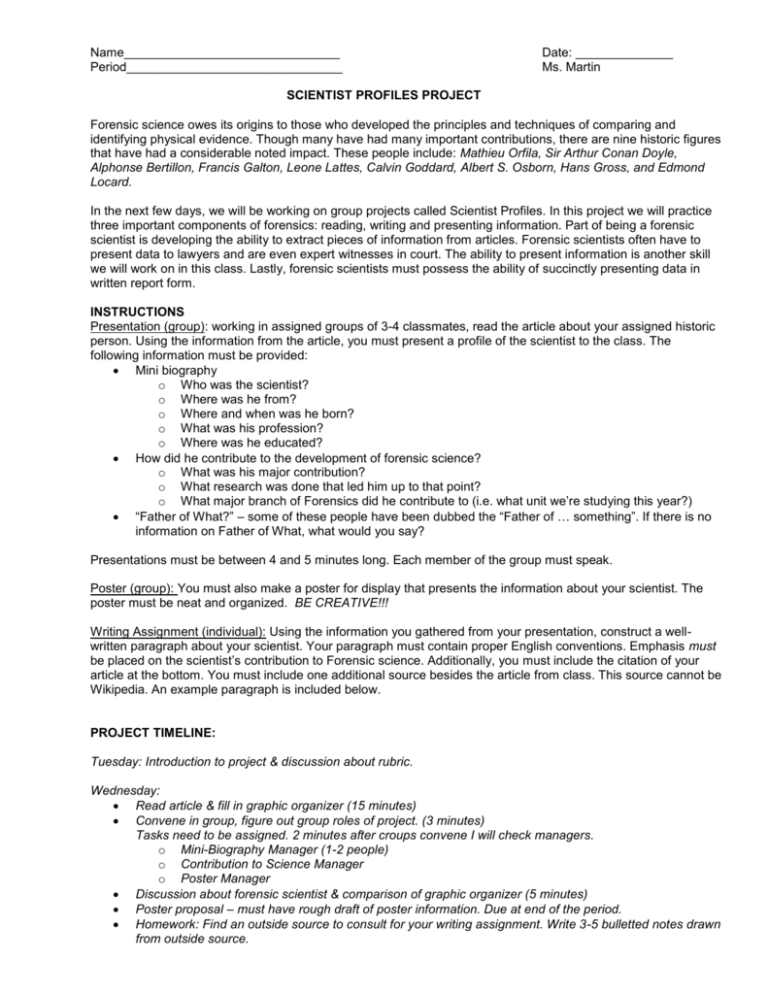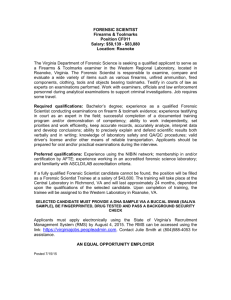ScientistProfile-instructions.doc - Ms-Martin
advertisement

Name_______________________________ Period_______________________________ Date: ______________ Ms. Martin SCIENTIST PROFILES PROJECT Forensic science owes its origins to those who developed the principles and techniques of comparing and identifying physical evidence. Though many have had many important contributions, there are nine historic figures that have had a considerable noted impact. These people include: Mathieu Orfila, Sir Arthur Conan Doyle, Alphonse Bertillon, Francis Galton, Leone Lattes, Calvin Goddard, Albert S. Osborn, Hans Gross, and Edmond Locard. In the next few days, we will be working on group projects called Scientist Profiles. In this project we will practice three important components of forensics: reading, writing and presenting information. Part of being a forensic scientist is developing the ability to extract pieces of information from articles. Forensic scientists often have to present data to lawyers and are even expert witnesses in court. The ability to present information is another skill we will work on in this class. Lastly, forensic scientists must possess the ability of succinctly presenting data in written report form. INSTRUCTIONS Presentation (group): working in assigned groups of 3-4 classmates, read the article about your assigned historic person. Using the information from the article, you must present a profile of the scientist to the class. The following information must be provided: Mini biography o Who was the scientist? o Where was he from? o Where and when was he born? o What was his profession? o Where was he educated? How did he contribute to the development of forensic science? o What was his major contribution? o What research was done that led him up to that point? o What major branch of Forensics did he contribute to (i.e. what unit we’re studying this year?) “Father of What?” – some of these people have been dubbed the “Father of … something”. If there is no information on Father of What, what would you say? Presentations must be between 4 and 5 minutes long. Each member of the group must speak. Poster (group): You must also make a poster for display that presents the information about your scientist. The poster must be neat and organized. BE CREATIVE!!! Writing Assignment (individual): Using the information you gathered from your presentation, construct a wellwritten paragraph about your scientist. Your paragraph must contain proper English conventions. Emphasis must be placed on the scientist’s contribution to Forensic science. Additionally, you must include the citation of your article at the bottom. You must include one additional source besides the article from class. This source cannot be Wikipedia. An example paragraph is included below. PROJECT TIMELINE: Tuesday: Introduction to project & discussion about rubric. Wednesday: Read article & fill in graphic organizer (15 minutes) Convene in group, figure out group roles of project. (3 minutes) Tasks need to be assigned. 2 minutes after croups convene I will check managers. o Mini-Biography Manager (1-2 people) o Contribution to Science Manager o Poster Manager Discussion about forensic scientist & comparison of graphic organizer (5 minutes) Poster proposal – must have rough draft of poster information. Due at end of the period. Homework: Find an outside source to consult for your writing assignment. Write 3-5 bulletted notes drawn from outside source. Thursday: Outside information for the writing assignment is due – I need to see bulleted note sheet with outside information. Poster construction (15 minutes) Practice for presentation (10 minutes) First three presentations. Mathieu Orfila, Alphonse Bertillon, Francis Galton Friday: Writing assignment due All of the rest of the presentations will go: Leone Lattes, Calvin Goddard, Albert S. Osborn, Hans Gross, and Edmond Locard. See rubric on the back of this page for grading breakdown! Sir Arthur Conan Doyle: Father of Crime Writing Sir Arthur Conan Doyle had a considerable influence on popularizing scientific methods of crime-detection through his character Sherlock Holmes. Doyle was born in Scotland in 1859. Though he went to school to become a medical doctor, Doyle eventually gave up practice as an ophthalmologist to become a writer. Doyle had a considerable influence on popularizing scientific methods of crime-detection thru his character Sherlock Holmes. Doyle would read about fingerprinting, serology, document examination and ballistics, and would incorporate it into his stories! He was the first to actually apply them, even if only in fiction. The exciting crimedetection practiced by Holmes inspired an emerging generation of forensic science who took fiction and made it fact. "Doyle, Arthur Conan." World of Forensic Science. Ed. K. Lee Lerner and Brenda Wilmoth Lerner. Gale Cengage, 2006. eNotes.com. 2006. 13 Sep, 2009 <http://www.enotes.com/forensic-science/ doyle-arthur-conan> Discussion Questions for the Rubric: 1. What would a group presentation have to look like to get a 4? What are absolutely essential parts to include? What could make your groups’ presentation stand apart for the rest? How can you ensure that your classmates learn the information? 2. Describe what a poster would look like to get a 4? What would you group have to focus on to make sure that you get a 4? What are some ideas to make the poster more creative? 3. What must be included in the writing assignment to get a 4? What information must be added to the writing assignment that wasn’t in the presentation? 4. What can I do to personally make sure that my group meets all deadlines? My individual deadlines?







